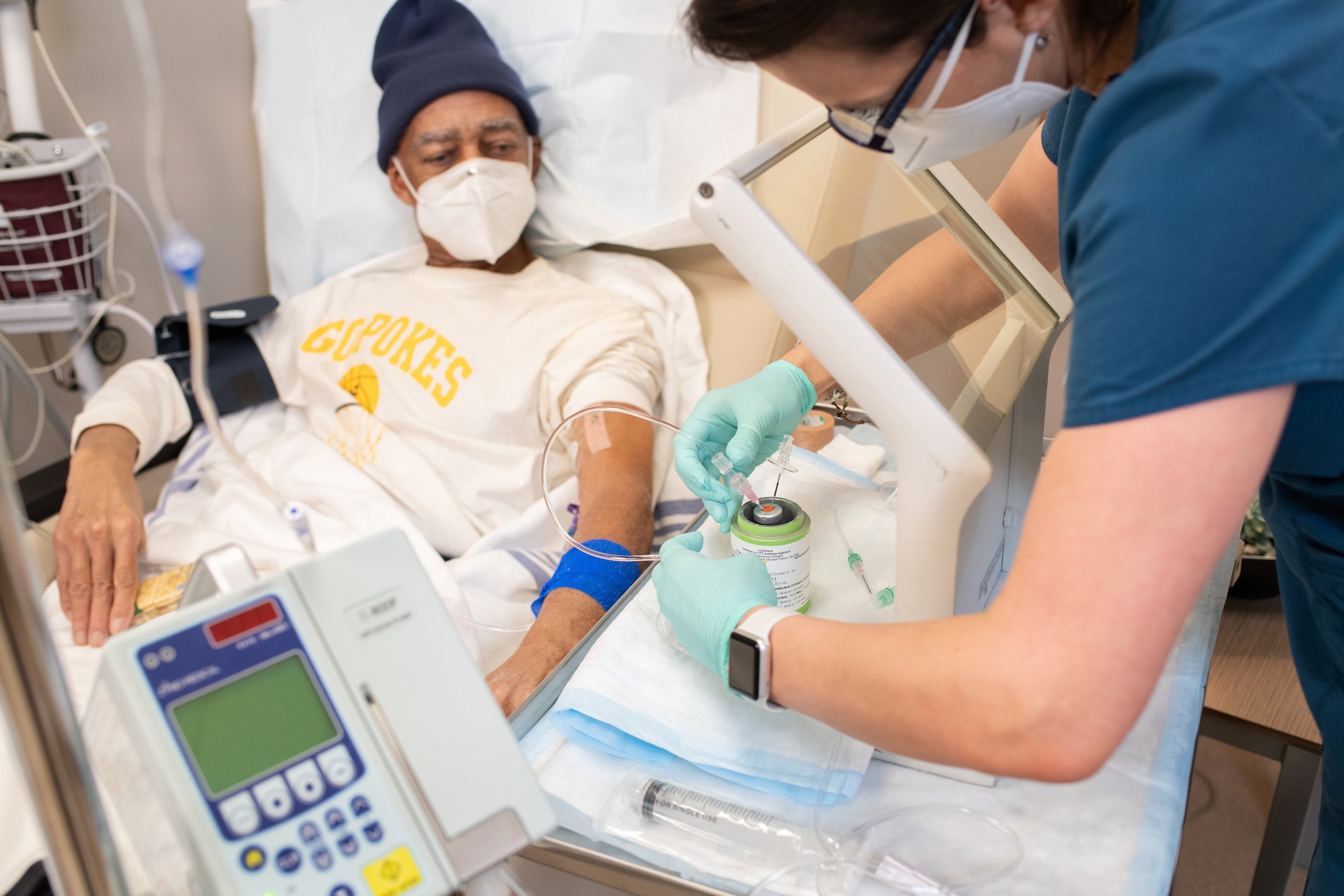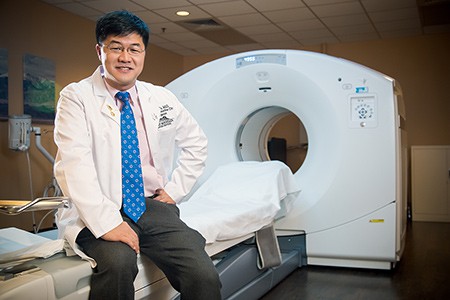Unique Approaches to Neuroendocrine Cancer
5 min read

Author: Eric Liu, MD
Though it can appear anywhere in the body, neuroendocrine cancer is a rare disease. Its symptoms can be misleading and diagnosis can be tricky. In addition, treating neuroendocrine cancer is a complex process – there is no one-size-fits-all approach.
 Luckily for patients at Rocky Mountain Cancer Centers (RMCC), we have one of the world’s leading experts on treating neuroendocrine tumors (NETs), Dr. Eric Liu, FACS, chief medical director of surgery for the Neuroendocrine Institute at RMCC. Along with a multidisciplinary team of medical experts, Dr. Liu delivers a range of innovative NET therapies.
Luckily for patients at Rocky Mountain Cancer Centers (RMCC), we have one of the world’s leading experts on treating neuroendocrine tumors (NETs), Dr. Eric Liu, FACS, chief medical director of surgery for the Neuroendocrine Institute at RMCC. Along with a multidisciplinary team of medical experts, Dr. Liu delivers a range of innovative NET therapies.
What treatment is right for you? That depends on the size and location of your NET, whether it is growing or causing symptoms, if it is cancerous, how healthy you are, and other factors. Taking these factors into consideration, your care team may prescribe one or more of the following treatment methods.
Theranostics: A Unique Approach to Radiation Therapy
Theranostics combines diagnosis and treatment. Dr. Liu pioneered this innovative approach in the United States.
Neuroendocrine cancer theranostics begins with an injection of radiation, which gets absorbed by NETs, causes them to “light” up, and makes them easily detectable by special imaging technology called a DOTATATE PET scan. There are other kinds of PET scans, but there is one especially for neuroendocrine.
Once the tumors are identified, Dr. Liu can employ another treatment called Lutathera. This injectable radioactive medication attaches to protein receptors on NETs, delivering radiation that attacks the cells’ DNA. Over time, it “stuns” the cancer so that it stops growing. In some cases, it causes the disease to shrink. Lutathera can be used in combination with DOTATATE PET scans.
RMCC has unique expertise in Lutathera and recently opened a new nuclear medicine suite to improve access to this treatment and protect staff who deliver the injectable medications.
Biting the Hand That Feeds NETs: Hormone Therapy and Embolization
NETs produce hormones and slowing or stopping that production gives physicians one way to help patients feel better. Treating NETs with hormone therapy typically involves one of two medications, ocreotide and lanreotide, depending on the type of tumor.
- Ocreotide can benefit people with symptoms, such as diarrhea, caused by slow growing (carcinoid) and pancreatic tumors, although it can also be used to treat acromegaly, in which the pituitary gland creates too much growth hormone. It slows down the body’s production of hormones. It can also slow down the growth of the cancer itself.
- Lanreotide is used to control tumor growth in people with pancreatic or gastrointestinal NETs. Like ocreotide, it can also be used to treat acromegaly.
Both are delivered as monthly injections that get released into the body slowly. One benefit of these treatments is that most cancer centers can provide them, making it easy for people with NETs to get the care they need even if they’re traveling.
In addition to hormones, neuroendocrine cancers need blood vessels to thrive, and a procedure called embolization helps deprive them of blood. It’s used when neuroendocrine cancers spread to the liver, which, according to Dr. Liu, is the most common place these cancers spread. RMCC oncologists work with interventional radiologists to perform these procedures. During an embolization, the arteries feeding blood to the tumor are identified and a substance is injected into the arteries flowing to the tumor. This substance clogs the artery and blocks blood flow to the NET, ultimately causing some of the tumor to die, but frequently getting them to shrink and not grow for a period of time. In some cases, embolization may use radioactive beads or beads filled with chemotherapy medication, which may attack the tumor in different ways.
Surgery to Address Tumors and Life-Threatening Complications
Surgical treatment is one of the most common options for NETs and neuroendocrine cancer. In fact, more than half of patients with an NET or neuroendocrine cancer undergo surgery.
Tumor removal is a primary goal of most surgeries, as it helps to prevent possible complications. Since many NETs are slow growing, the bigger concern is a life-threatening complication, such as blockages, bleeding, and blood clots, or other symptoms that result from a tumor’s mere presence or even hormone production. Surgical removal can help patients avoid some of those complications.
For those with noncancerous NETs, surgery may be the only treatment necessary. During the procedure, a surgeon removes as much of your tumor as possible. If it is possible to do so, the entire tumor is removed. The surgeon also removes healthy tissue surrounding the cancer which reduces the risk that cancer gets left behind.
A common surgical procedure for NETs is ablation, which allows surgeons to destroy the targeted tumors. The ablation process is usually minimally invasive or done at the time of surgery, which makes it a good option if the patient’s tumor is small. Ablation can also help when neuroendocrine cancer spreads to nearby organs. Most of the time, providers ablate NETs with heat or cold gasses. Radio waves, microwaves, ethanol, or liquid nitrogen provide the extreme temperatures. During the procedure, the provider guides a thin probe to the tumor. Once there, the extreme heat or cold is aimed at the tumor to destroy it.
Watch and Wait
 Sometimes NETs and neuroendocrine cancer do not grow quickly or do not cause troublesome symptoms. As a result, some patients do not always need immediate treatment. In these cases, the treatment team may suggest active surveillance - watchful waiting.
Sometimes NETs and neuroendocrine cancer do not grow quickly or do not cause troublesome symptoms. As a result, some patients do not always need immediate treatment. In these cases, the treatment team may suggest active surveillance - watchful waiting.
While waiting to see how your cancer progresses, you will see your provider regularly so they can check in on your cancer to track any changes. During these visits, your provider may conduct the following:
- Blood tests
- CT, MRI, PET, or other imaging scans
- Physical exams
- Other tests
If the tumor grows or causes symptoms, your treatment team will adjust your treatment according to evidence-based treatment methods. If treatment is necessary, your team may recommend one of the approaches outlined above or a more traditional therapy, such as:
- Chemotherapy, medication that kills cancerous cells
- Immunotherapy, which bolsters your immune system’s ability to fight cancer
- Radiation therapy, high-intensity radiation aimed at your tumor
Neuroendocrine cancer treatment requires a multidisciplinary approach and specialized expertise. We have that expertise here at RMCC with a world-class cancer treatment team relentlessly dedicated to providing patients with the most optimal cancer care. We provide patients with not only a treatment plan catered to their specific needs, but we also support them through their cancer journey and beyond.
Learn more about our neuroendocrine specialists and how we treat neuroendocrine tumors at RMCC.